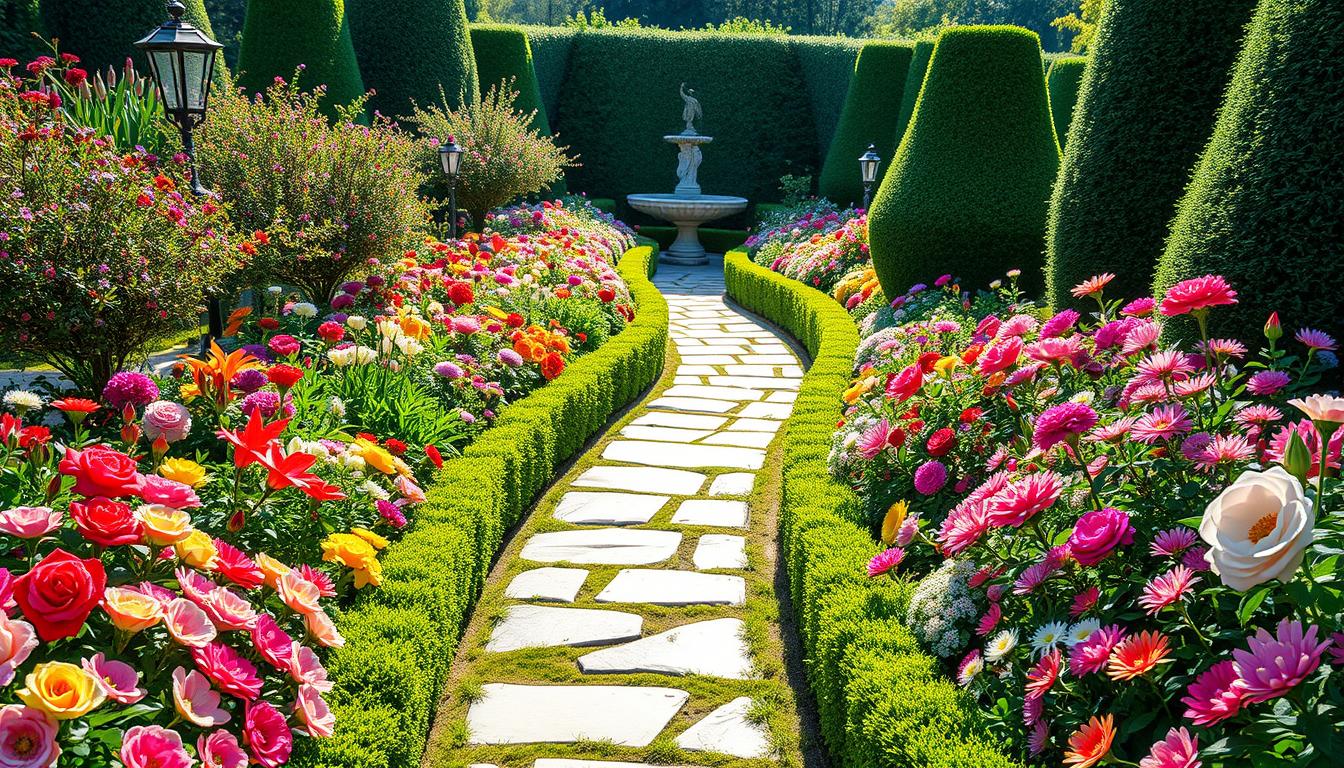Transforming your outdoor space into a thriving oasis has never been easier. With the right tools, both beginners and experienced enthusiasts can achieve stunning results. A flower garden layout planner simplifies the process, offering precision and creativity in every step.
Tools like the Almanac Garden Planner provide a free trial and advanced features, including 3D visualization. This makes it easy to experiment with different designs before committing to a plan. Similarly, Planner 5D offers a user-friendly platform with drag-and-drop functionality, perfect for crafting detailed layouts on the go.
Proper planning not only enhances the beauty of your space but also improves success rates for blooming seasons and pest control. Thoughtful design can even boost property value, making it a worthwhile investment. Modern tools help avoid common mistakes, such as poor sun exposure planning, while also attracting pollinators through strategic placement.
Compared to traditional methods like graph paper, these tools save time and effort. Real-world success stories from places like Nova Scotia and Ohio highlight the transformative power of using a garden planner. Whether you’re starting small or redesigning an entire space, these tools make gardening more accessible and enjoyable.
Ready to get started? Check out our guide on how to start a garden in 8 simple for more tips and inspiration.
Key Takeaways
- Specialized tools simplify garden planning for all skill levels.
- Almanac Garden Planner offers a free trial and 3D visualization features.
- Planner 5D provides a user-friendly platform with drag-and-drop functionality.
- Proper planning increases success rates and boosts property value.
- Modern tools save time and help avoid common mistakes.
Why Flower Gardens Are a Must-Have Addition to Your Life
Flowers bring more than beauty—they enhance life in surprising ways. Whether you’re looking to boost your mood or support local ecosystems, a vibrant outdoor space can make a significant difference. Let’s explore the many reasons why this addition is worth your time and effort.
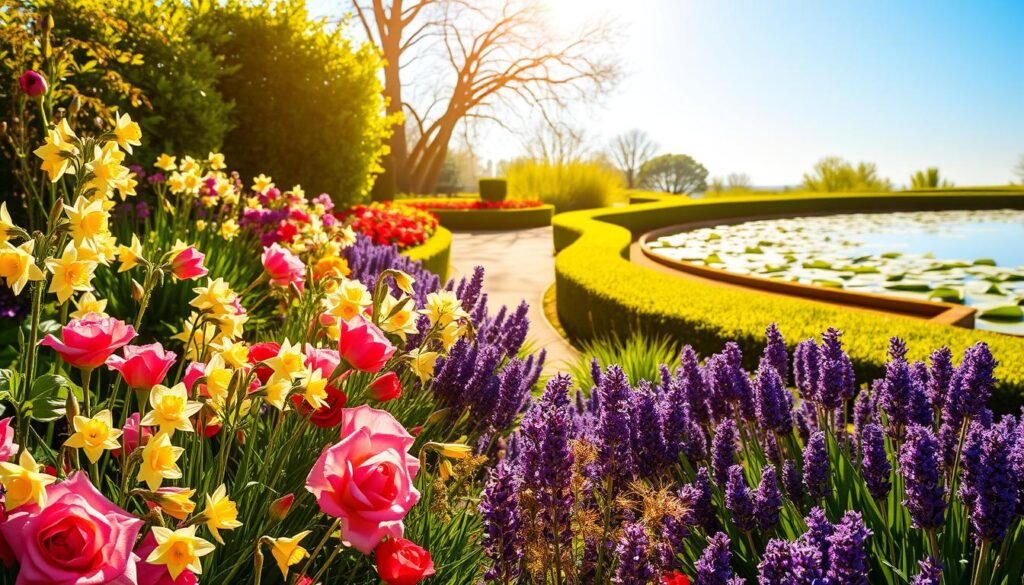
The Beauty and Benefits of Flower Gardens
Scientific studies show that flower gardens increase local pollination rates by 70%. Plants like calendula and marigolds are especially effective, making them a smart choice for any outdoor space. Beyond their ecological impact, these blooms also create a spillover effect, improving the aesthetics of entire neighborhoods.
Take Woodstock Flower Farm in Nova Scotia, for example. Their seed-to-bouquet approach has not only beautified the area but also inspired others to start their own projects. Similarly, zinnias and overwintering biennials offer natural pest control, reducing the need for harmful chemicals.
How Flowers Enhance Well-Being and Pollination
Rutgers University research highlights the mental health benefits of floral exposure. Spending time around blooms can reduce stress and increase happiness. Whether you choose cut flowers or potted plants, the emotional impact is undeniable.
From a cost perspective, starting a garden is surprisingly affordable. Seed packs priced at $0.99 can yield stunning results, offering a budget-friendly alternative to professional landscaping. Plus, the sensory benefits—fragrance, visual appeal, and tactile experiences—make it a rewarding endeavor.
For those looking to turn their passion into profit, consider the success of Rushville, IL’s cut-your-own garden, which generates $15k annually. Whether for personal joy or community impact, flower gardens are a worthwhile investment. For more inspiration, check out our guide on boho yard decor ideas to elevate your space.
Getting Started with a Flower Garden Layout Planner
Designing a vibrant outdoor space starts with the right tools. A garden planner can simplify the process, helping you create a detailed and functional design. Whether you’re a beginner or an expert, these tools make it easy to visualize and execute your ideas.
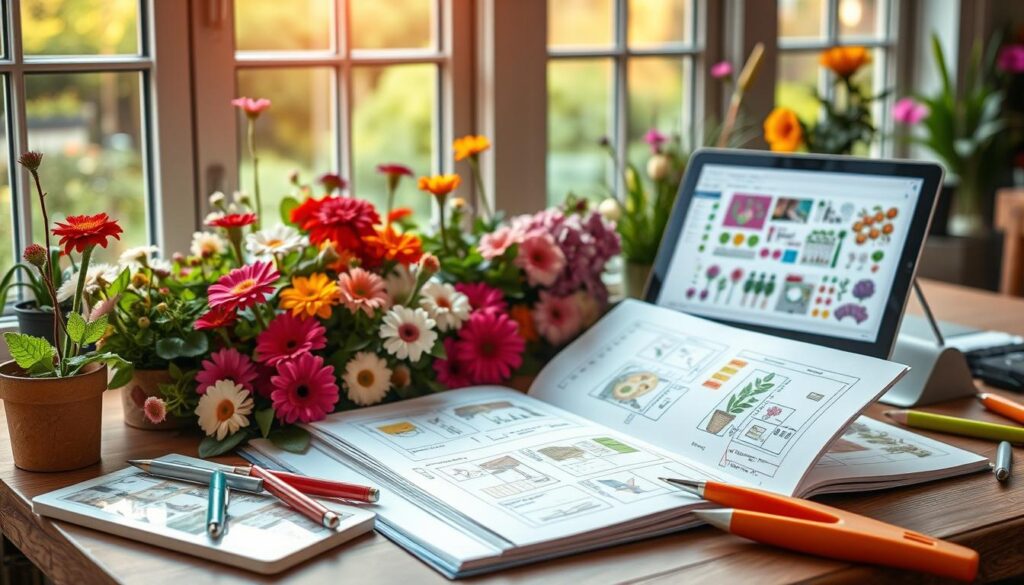
Choosing the Right Garden Planner Tool
Selecting the best tool depends on your needs and skill level. Almanac Planner is ideal for those who want automatic tracking of bloom seasons and plant spacing. On the other hand, Planner 5D offers 2D-to-3D conversion with color and texture editing, perfect for advanced users.
| Feature | Almanac Planner | Planner 5D |
|---|---|---|
| Skill Level | Beginner to Intermediate | Intermediate to Advanced |
| Visualization | 2D | 2D and 3D |
| Customization | Basic | Advanced |
| Mobile App | Yes | Yes |
Customizing Your Garden Layout
Customization is key to creating a space that suits your needs. For example, raised bed designs work well for clay soil, as seen in Ohio. Input specific measurements, like 34’11” x 25’0″, to ensure accuracy. Circular bed patterns or 41’11” row layouts can add variety to your design.
“The right plan can transform any space into a thriving area.”
Visualizing Your Design in 3D
3D visualization helps you spot potential issues before starting. For instance, a Cincinnati project used sun tracking features to optimize plant placement. Importing plant databases into digital planners ensures you account for mature sizes, avoiding overcrowding.
With mobile app functionality, you can make adjustments on-site. Avoid common mistakes like improper scale setting to ensure your plan is flawless. Modern tools save time and effort, making gardening more enjoyable.
Selecting the Perfect Plants for Your Garden
The key to a thriving outdoor area lies in selecting the perfect plants. Whether you’re a beginner or an experienced enthusiast, understanding the details of plant types and bloom seasons is essential. This ensures your space remains vibrant and functional throughout the year.
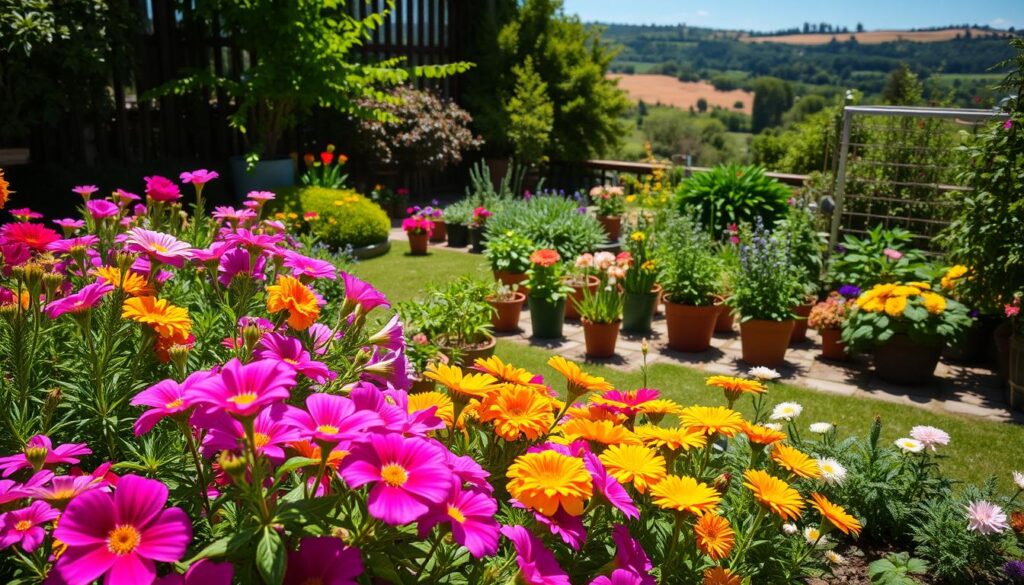
Understanding Plant Types and Bloom Seasons
Plants can be categorized into annuals and perennials, each with unique benefits. Annuals, like marigolds and calendula, bloom for one season but attract beneficial insects by up to 40%. Perennials, on the other hand, return year after year, offering long-term value.
Sterling, VA’s border garden uses a staggered bloom schedule over 25’0″ to ensure continuous color. Analyzing bloom cycle charts from their 3-year observation data can help you plan effectively. For budget-conscious planting, $0.99 seed packs are a great starting point.
Creating a Balanced Plant Palette
Color theory plays a crucial role in creating harmonious combinations. Pairing complementary colors, like purple and yellow, can make your space visually appealing. Companion planting strategies, such as those used in Ohio’s clay soil gardens, also enhance growth and pest resistance.
For larger spaces, calculating plant quantities is vital. A 2400 sq ft area requires careful planning to avoid overcrowding. Pest-resistant varieties, like those used in Rushville’s commercial operation, ensure healthier growth. Tools like Planner 5D can simulate plant growth over five seasons, helping you refine your design.
“The right plant choices can transform any space into a thriving area.”
By following these tips, you can create a balanced and beautiful outdoor retreat. Whether you’re working with a small plot or a large area, thoughtful selection ensures success.
Designing Your Dream Garden Layout
Crafting a stunning outdoor retreat starts with thoughtful planning. Whether you’re working with a small plot or a sprawling area, the right design can make all the difference. From understanding sun exposure to choosing the best planting methods, every detail matters.
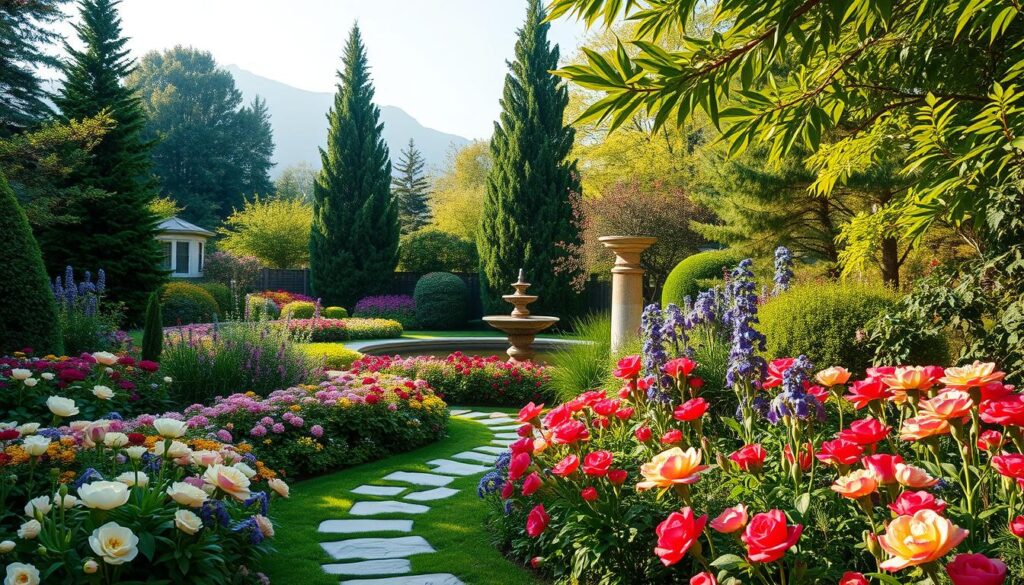
Planning for Sun, Shade, and Soil Conditions
Sunlight and soil are the foundation of any successful outdoor space. In Cincinnati, a 28’11” x 19’11” clay soil layout was transformed by using sun mapping techniques. Tools like Planner 5D offer shadow simulation to help you track sunlight throughout the day.
For heavy clay soil, consider these soil amendment recipes:
- Mix compost and sand to improve drainage.
- Add gypsum to break up compacted soil.
- Use organic matter like peat moss to enhance fertility.
Proper drainage is also crucial, especially for sloped areas. A 41’11” sloped garden in Ohio used French drains to prevent waterlogging.
Incorporating Raised Beds and Traditional Rows
Raised beds and traditional rows each have unique benefits. In Nova Scotia, a 34’11” x 25’0″ raised bed layout increased productivity by 30%. Raised beds are ideal for controlling soil quality and reducing weeds.
Traditional rows, on the other hand, work well for larger spaces. Ohio’s clay soil gardens achieved impressive yields using this method. Here’s a quick comparison:
| Feature | Raised Beds | Traditional Rows |
|---|---|---|
| Soil Control | High | Moderate |
| Weed Reduction | Excellent | Good |
| Space Efficiency | Compact | Spacious |
Inspiring Layout Ideas from Real Gardens
Looking for inspiration? Virginia’s border garden achieved a 300% increase in cut flower production by using succession planting in a 19’11” x 29’11” space. Here are five proven color progression patterns from professional designers:
- Monochromatic: Shades of one color for a calming effect.
- Complementary: Pairing opposite colors for contrast.
- Analogous: Using neighboring colors for harmony.
- Triadic: Three evenly spaced colors for vibrancy.
- Warm vs Cool: Balancing warm and cool tones for depth.
“The right plan can transform any space into a thriving area.”
From front border designs to backyard farm layouts, these ideas can help you create a space that’s both functional and beautiful. Whether you’re working with a $500 budget or investing $5k, thoughtful planning ensures success.
Conclusion: Bring Your Garden Vision to Life
Bringing your outdoor vision to life is easier than ever with the right tools. Almanac users report an 89% satisfaction rate with planner-guided designs, and 74% complete their plans in under two hours. Start with free tools to explore your ideas before upgrading to premium features.
For those looking to turn their space into a profitable venture, consider replicating Rushville’s 2400 sq ft model. Seasonal maintenance tips and a 30-day action plan, inspired by Sterling, VA’s border garden, can help you stay on track. Troubleshoot common first-year mistakes with our expert guide.
Take advantage of an exclusive Almanac discount for readers who complete their designs. Before-and-after photos of Ohio’s clay soil transformation provide the perfect inspiration to get started. Use mobile app features to begin your 3D design today and bring your plan to life.

